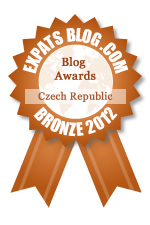By Ricky, on May 30th, 2013
Towers at the eastern end of the Prague Castle complex © Ricky Yates
Many of us here in Prague, are beginning to think that someone has kidnapped Spring and early Summer, the weather having been cold and wet for most of May. So Sybille and I decided to take full advantage of a rare, fine, dry and partly sunny evening earlier this week, and take a walk through some of Prague’s wonderful green spaces.
We took the tram to Pražský hrad / Prague Castle. But instead of crossing Prašný most, the bridge over Jelení príkop, and entering the Castle complex, we turned left into Královská zahrada, the Royal Gardens. As well as a wonderful collection of mature trees, there were several rhododendron bushes still in flower – shades of our visit to Pruhonice Park the previous week.
From the Royal Gardens, there are . . . → Read More: Royal Gardens, Stalin and the Metronome
By Ricky, on November 26th, 2012
The Brandenburger Tor/Brandenburg Gate © Ricky Yates
The Sony Centre, Potsdamer Platz © Ricky Yates
The Brandenburger Tor/Brandenburg Gate lies at the heart of the Historic Mitte/Historic Centre of Berlin. It was the backdrop to the events of 9th November 1989 that unfolded on television screens around the world and to which several people have made reference in their comments on my previous post about the Berlin Wall. As can be seen in my photograph above, it has now been fully restored to its former glory and it is hard to imagine the concrete panels of the Wall dividing east from west, that used to run directly in front of it.
A short distance south of the Brandenburg Gate is Potsdamer Platz, which until the Second World War, was the bustling heart of the city. Post 1945, it lay in ruins . . . → Read More: Berlin
By Ricky, on November 19th, 2012
A preserved section of the Berlin Wall © Ricky Yates
It is more than a little ironic that Berlin’s most popular tourist attraction, for the most part no longer exists! For 28 years, the Berlin Wall symbolised the Cold War and the division of Europe between the democratic and capitalist west, and the communist one-party states of the east, even if the communists did try to proclaim themselves as ‘democratic’ with the official name of the former East Germany being the Deutsche Demokratische Republik (DDR).
Construction of the wall began shortly after midnight on 13th August 1961 when thousands of East German soldiers and police rolled out massive lengths of barbed wire, cutting streets in two and preventing East Germans from travelling into West Berlin. Shortly afterwards, the barbed wire was replaced with a wall made of concrete slabs.
The Berlin Wall was a desperate measure by . . . → Read More: The Berlin Wall
By Ricky, on May 8th, 2012
Statue of Soviet Marshall Ivan Konev with floral tributes © Ricky Yates
Inscription alongside the statue © Ricky Yates
Today is a public holiday here in the Czech Republic, as it is in several other European countries. The public holiday marks the ending of World War Two, sixty-seven years ago, on 8th May 1945.
I took the photograph on the left today. It is of a statue that stands in Námestí Interbrigády, a large square on one side of Jugoslávských partyzánu, the main thoroughfare leading from our nearest Metro station at Dejvická, to Podbaba where we live. And the person it portrays is Marshall Ivan Stepanovich Konev of the Soviet Red Army, who led the troops that liberated Prague from Nazi occupation, finally entering the city early on 9th May 1945, just a few hours after the unconditional surrender of all Nazi troops . . . → Read More: Liberation Day – 8th May 2012
By Ricky, on October 7th, 2011
View along a side street in Central Bucharest © Ricky Yates
I spent a further 24 hours in Bucharest following our Archdeaconry Synod meeting, not least because flying back to Prague on Monday afternoon was far cheaper than flying back on Sunday evening! I used the time exploring the city centre by bus and on foot, and I hope that these photographs will give readers of my blog, some impression of what Bucharest is like.
Looking at the photograph on the left, it would be very easy to think that it was taken in Paris or another French city, rather than in Bucharest. And many of the most attractive buildings dating from the latter half of the nineteenth century and the early part of the twentieth century do display a French architectural style. This is because of the strong French-Romanian links during this time period . . . → Read More: Bucharest
|
rickyyates.com is a participant in the Amazon Services LLC Associates Program, an affiliate advertising program designed to provide a means for sites to earn advertising fees by advertising and linking to Amazon.
|



Recent Comments